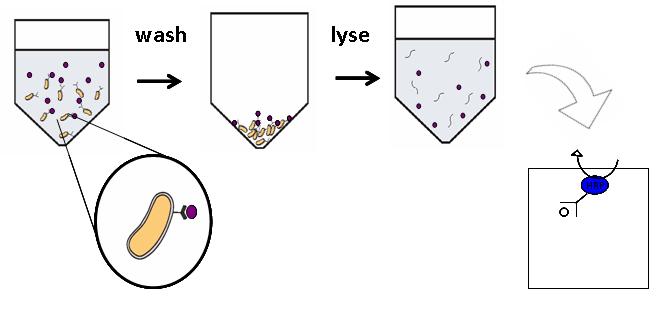Team:Berkeley Wetlab/Passenger: TypeIII Needle scFv
From 2009.igem.org
TypeIII Needle scFv
The TypeIII secretion system (TTSS) is present in many pathogenic bacteria such as E. Coli O157:H7 and is a mechanism of their virulence. Specifically, EspA, a subunit of the TypeIII secretion complex, is a virulence factor expressed by both Enteropathogenic and Enterohaemorrhagic (EHEC)bacteria. It has a filament structure that aids in delivery of effector proteins to the host cell. Conditions such as haemorrhagic colitis are caused by EHEC. The surface display of an scFv (single-chain variable fragment) that can bind to espA can disrupt the function of the TTSS, which may have probiotic as well as pathogen detection applications.
Functional Assay: Dot Blot
This assay measures the success of E. coli surface display of typeIII needle scFv and its ability to bind specifically to espA protein, a subunit of the typeIII needle complex in EHEC.
basic theory behind experiment The incubation of cells expressing the anti-espA scFv with espA protein allows for specific binding. The washes following incubation separates the bound and unbound espA proteins, such that when the cells are lysed, only the bound espA protein is released into solution and subsequently blotted onto the nitrocellulose. An anti-his antibody conjugated to HRP is used to probe the blot for the his-tagged espA. Signals are read via chemiluminescence.
constructs:
Needle scFv (14)
Gliadin neg control (2)
No pass neg control (14)
1363 negative control (1)
All experiments are done in triplicate
cell growth and induction
- inoculate cells from stock into LB with appropriate antibiotics and grow to saturation overnight (12+ hours)
- dilute culture 1:100 into media with arabinose and induce for 5-12hours
- pipet 100ul of cells to Costar V-bottom polystyrene plate and take OD
- pellet cells and flick out media
incubation with espA protein
- add 5ul of espA protein to 95ul of PBS buffer and resuspend cells in solution
- incubate for 1.5 hours
- wash 3X with PBS buffer on plate washer
- take OD on 3rd wash
- after last wash, pellet cells, and resuspend in 50ul lysis buffer
- heat for 15-20 minutes to lyse all cells
dot blot and visualization
- pipet 5ul of cell lysate onto nitrocellulose paper and allow to dry completely
- wet nitrocellulose with 10ml of 1X TBST for 5minutes
- block with 2% BSA (.2g BSA in 10ml 1X TBST)for 1 hour
- wash 3X with TBST - 5minutes/wash
- add 4ml of 1:500 Anti-His HRP: TBST, wait 30minutes
- wash 3X with TBST - 5minutes/wash
- leave the last wash on for developing
- add 3mls of chemiluminescent reagents to the nitrocellulose paper and take pictures
Results
Displayers + TypeIII Needle scFv
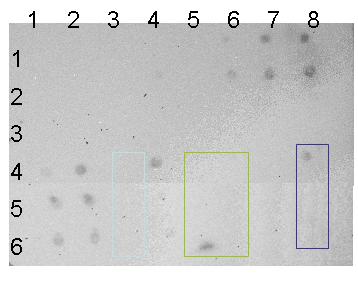
lysis buffer only negative
gliadin scFv negative
No display (1363) negative

Most of the constructs have signals larger than the negative control, but two of them gave higher signals than the rest: hia and upaG_short.
These dot blots have not been normalized to protein concentration. However, this does not make a significant difference in the results since the starting ODs (indicating growth) of the bacteria for the constructs and negative controls do not significantly differ.
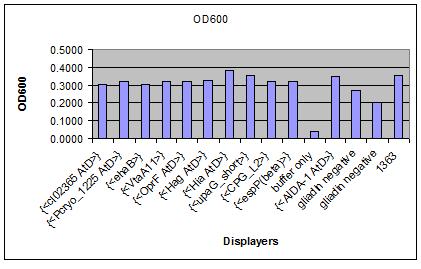
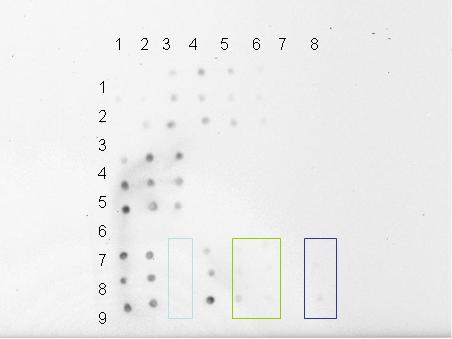

The negative controls did not have significant signal.
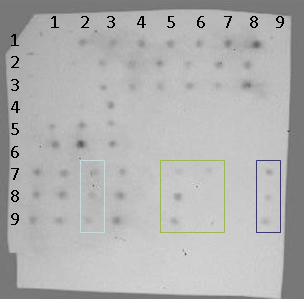

There is some detectable background as denoted by the slight signals in the column with just lysis buffer.
Several of the Needle scFv constructs did have positive signals higher than that of the negative controls. (yuaQ and upaG_short)
Displayers Only (negative)
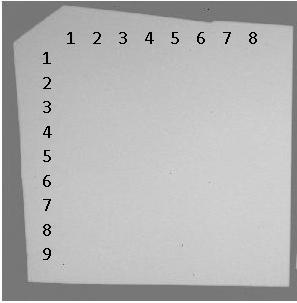
No detectable signal is present in the set of experiments run with only displays expressed from the cells.
There were three constructs that showed higher signals consistently in all three sets of experiments. They are AIDA, espP, and cpg_L2.
Quantitaive Image J Analysis of Dot Blots

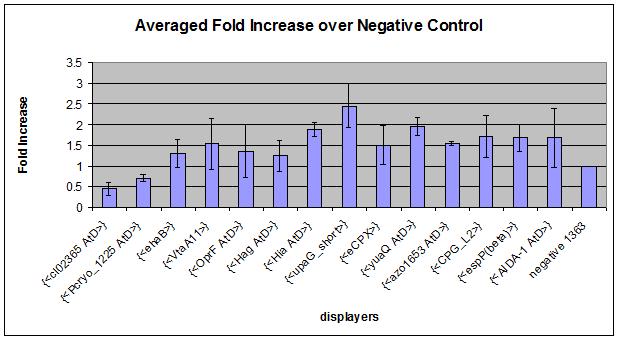
This data represents the averaged fold increase of three sets of data normalized to the negative control. The data indicates preliminarily the functional display of scFv with displayers Hia, upaG_short, yuaQ, CPG_L2, and espP(beta).
References
La Ragione, R et al. Recombinant anti-EspA antibodies block Escherichia coli O157:H7-induced attaching and effacing lesions in vitro. Microbes and Infection. September 2005; 8: 426–433. Available Online: http://www.sciencedirect.com/science?_ob=MImg&_imagekey=B6VPN-4H4T215-1-7&_cdi=6211&_user=4420&_orig=search&_coverDate=02%2F28%2F2006&_sk=999919997&view=c&wchp=dGLbVtz-zSkzS&md5=f35699db5dcd202f4cd1c1d8739d89b0&ie=/sdarticle.pdf (Accessed: 20 October 2009).
 "
"







